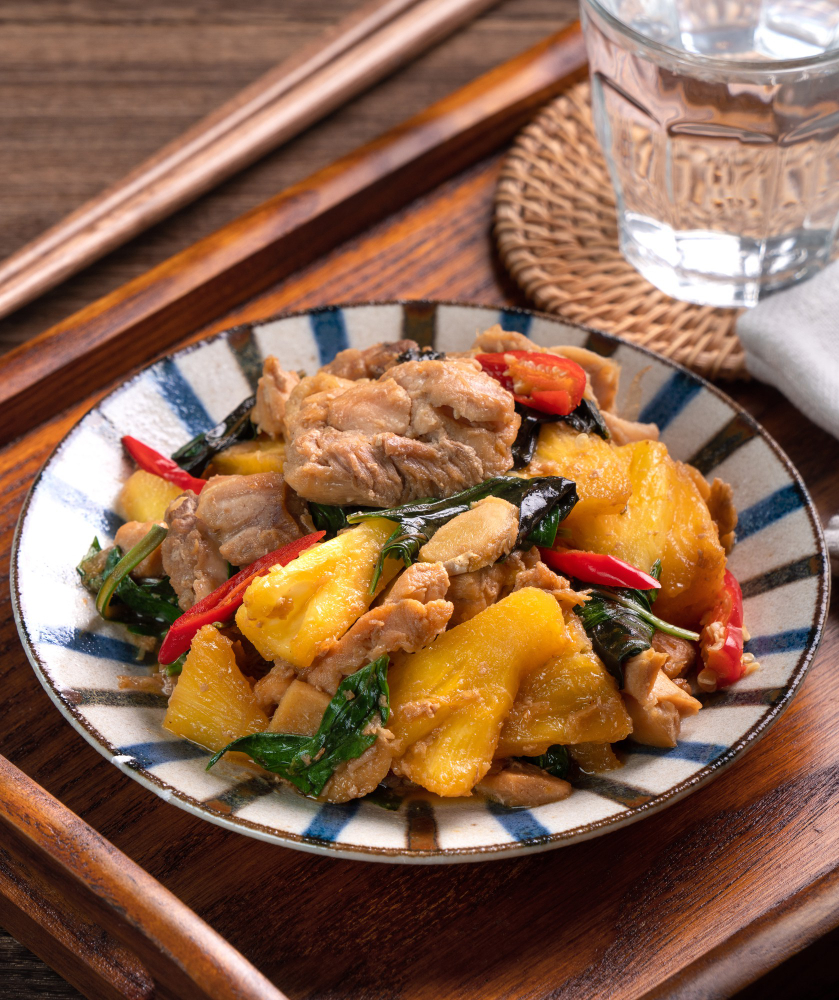Taiwanese recipes are very popular because of their flexibility in terms of rules, but this dish is an exception to that. It calls upon equal parts soy sauce, rice wine, and sesame oil to create a viscous, dark sauce for braising chopped pieces of bone-in chicken. These are the “three cups” in question, and from the dish’s name alone, a skeletal recipe emerges. These are what is referred to as the “three cup”, and only by looking at the dish’s name, a basic recipe can be inferred.
What the name doesn’t reveal is that Three Cup Chicken gets its intense flavour from heaps of whole garlic cloves and large rounds of ginger fried in sesame oil until golden-brown. When the chicken is added, they continue to simmer, blending with the sugar that has been added to the braising liquids, until soft and delicious. Even though the meal has Southern Chinese origins, it can only be identified as Taiwanese by the extensive use of fresh basil leaves at the end of cooking. The reddish-colored chicken is packed with the soft, delicate garlic cloves and mildly candied ginger when it’s time to serve, then covered in a slightly reduced sauce and sprinkled with herbs. It’s essentially an exercise in excess, and the outcome shows how beneficial that can be.
In Taiwan, San Bei Ji is now a staple on the menu at Taiwanese restaurants. The flavour profile of the dish has sparked a variety of adaptations, the most popular of which is braised squid or cuttlefish in the three-cup style. However, chicken is the traditional ingredient, and in order to prepare it authentically, it is usually cooked in an old-fashioned clay pot. Fortunately, you can do it rather easily at home in any pan or wok.
Typically, chicken would be sliced into bite-sized, bone-in pieces for San Bei Ji. For example, a drumstick might be cut in half or thirds crosswise, right through the bone. The size of other components would also be reduced. You can ask a butcher to make that type of cut for you, or if you’re feeling particularly daring, you can even give it a go yourself with a cleaver. However, at home, I choose to take the simpler route by simply cutting the chicken into pieces of roughly the same size without cutting through the bone. For instance, when I prepared this dish with chicken thighs and drumsticks, I sliced the thighs in half by cutting alongside—but not through—the bone and left the drumsticks alone, resulting in pieces that were almost the same size. Everything will cook evenly as a result of this.

Ingredients
- 1/4 cup Asian sesame oil
- One piece fresh ginger, peeled and thinly sliced
- 12-15 medium-sized garlic cloves, peeled
- 1-2 fresh Thai red chilies, stemmed and halved
- 900g skin-on chicken drumsticks, thighs, and/or wings, either chopped into 3-inch, bone-in pieces, or thighs halved along along the bone, wings split at the joint, and drumsticks left whole
- 1/2 cup rice wine
- 1/4 cup soy sauce
- 1 tablespoon sugar
- 2 cups fresh Thai basil leaves
- Steamed white rice, for serving
Directions
- In a sizable skillet or wok, heat sesame oil over medium-high heat until shimmering. Cook the ginger, garlic, and chilies for about a minute, or until they are quite fragrant.
- Place the chicken pieces in the skillet in a single layer and cook for 1 minute, tilting the pan if required to completely cover the chicken in oil. Cook the chicken pieces for another minute after flipping.
- Bring the rice wine, soy sauce, and sugar to a boil, stirring to dissolve the sugar. Reduce the heat to a low simmer. Cook, partially covering the skillet to prevent oil splashes, for about 15 minutes, turning the chicken pieces every few minutes, until the chicken is cooked through. Remove from heat and stir in Thai basil. Serve with rice right away.
